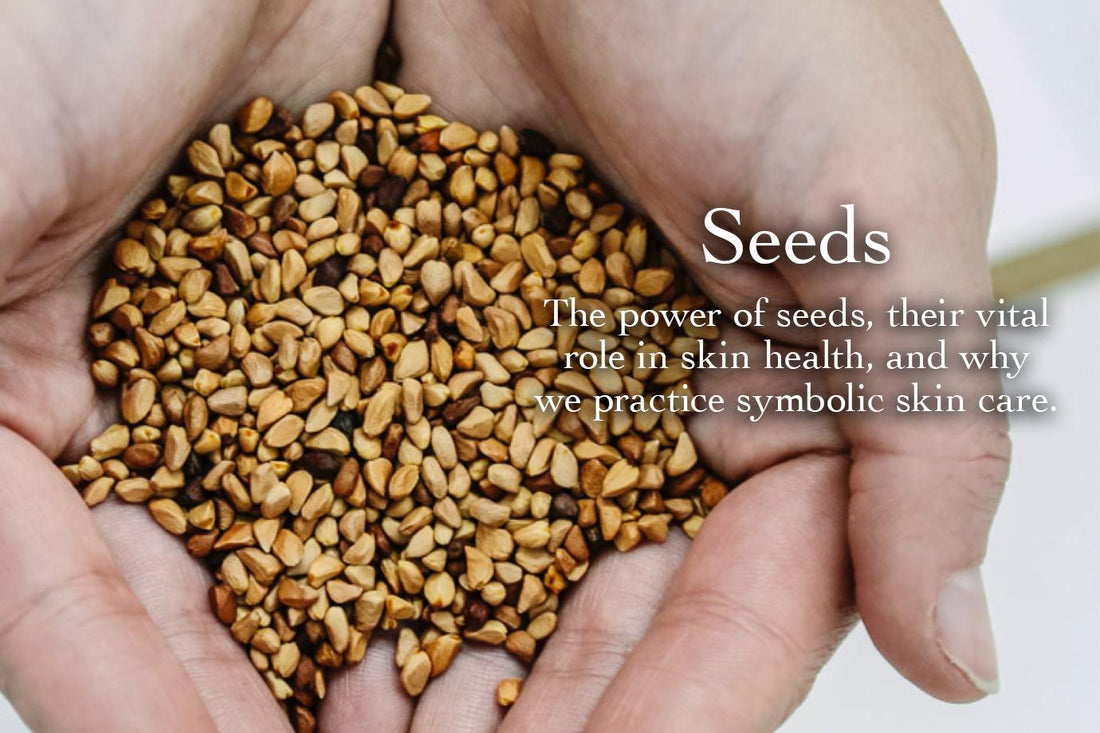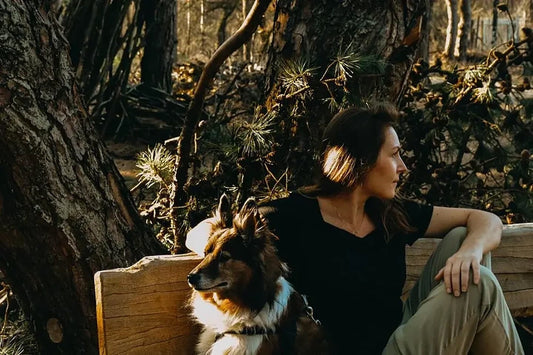The power of seeds, their vital role in skin health, and why we practice symbolic skin care
Seeds. Magical little vessels for life, dormant and waiting for awakening. Opportunity. Possibility. Building blocks for creation. Seeds are powerful things and the nutrition we gather from them can be truly transformative.
As plant lovers, and creators of whole botanical skin care, we love seeds. They are some of our favorite ingredients to work with, and play an integral role in many of our formulationsions. Seed oils, specifically, are the centerpiece for nearly all of our Oil Serums.
Rosehip, prickly pear, pomegranate, jojoba, sesame, sunflower, raspberry and avocado — these are just a few seeds in our repertoire.
Why do we love seeds, you ask? We love seeds for their near-miraculous ability to infuse their innate vitality and life force into the world and into the body. Like eggs, seeds contain an abundance of nutritive compounds, designed by nature to support the spark, birth and early stages of life. By incorporating seeds into our skin care rituals, we are able to bring these (re)generative, vitalizing, and transformative qualities into our beings.
Whole seeds contain protein, fat, vitamins, minerals and fiber. Most seeds have an incredibly high ratio of fat in comparison to other parts of a plant, which makes them an incomparable source for lipid nutrition. We believe this speaks to the importance of fat in the role of cell development, growth, and evolution. And it clearly communicates that the nutrients we absorb from seeds are vital building blocks for our own regeneration.
There are few things on this planet more important than seeds, especially when we consider the current climate crisis. Seed-saving is more essential than ever, especially heirloom and ancestral seeds. There are seed banks and seed collectors all over the world, as well as seed saving organizations. One of the most prominent collections is the Svalbard Global Seed Vault — a massive seed-saving library on a Norwegian island in the arctic circle, that exists as a safeguard in the case of an environmental apocalypse.
Seeds are immeasurably important, and we are lucky to have access to them as a source of nutrition for skin and body. When interacting with the human body, the life force within the seeds, the “generative” qualities becomesregenerative. Seeds are restorative, regenerative, and rejuvenating.
“Seeds are many things. Above all else, they are a way of survival of their species. They are a way by which embryonic life can be almost suspended and then revived to new development, even years after the parents are dead and gone. Seeds protect and sustain life. They are highly organized fortresses, well stocked with special supplies of food against long siege. Seeds are vehicles for the spread of new life from place to place by the elements and by animals and people. Seeds are food for man and animals and other living things…”
~ Victor R. Boswell, What Seeds Are and Do – An Introduction
The Power of Symbolic Skin Care
True holistic skin care must be more than skin deep, and must consider more than just the body. It must also consider the mind, the emotions, the soul, and the inextricable connection between all these things.
❋
Merriam-Webster defines holistic as:
relating to or concerned with wholes or with complete systems rather thanwiththe analysis of, treatment of, or dissection into parts
❋
To treat and care for the whole, you cannot separate it into parts. To use natural skin care but then feed your mind with toxic, disempowering beauty ideologies — that is not holistic skin care.
This is why our approach involves layers of meaning behind everything we do, and not just the physiological impact of the products themselves. And this is partially why symbolic action can be so powerful. It takes something that is very direct and straightforward, and to it adds layers of meaning.
Seeds are a symbol for new life.
Autumn is a symbol for death, and a time to go within.
Pomegranate, as a plant of many-many seeds who ripens in the autumn, is a symbol for life, death, rebirth, and regeneration.
It’s true the scientific breakdown of the ingredients we use plays a huge role in the efficacy of our product line, but the physical application is only part of the healing journey. Because of that, we lean into the power, and the feast, of symbolism. To plant symbolic seeds (pun intended) through our actions anchors us into a deeper layer of our humanity, and our very experience of our existence. Symbols and symbolic action are nourishment for our psyches. The psyche feasts on meaning, and on intention.
Whether it be cultural, familial, or personal — symbolism is powerful. By living a life where we allow symbols play an integral role creates for us a richer world, and a more magical experience of our lives.
To understand the symbolism of something, all you have to do is dig. Ask basic questions. What is the function of this? What does it do? What is its nature? Symbols and symbolic action have always played a meaningful role in the world of our ancestors. The ancient world was drenched with layered meaning, and to bring this into our lives can be transformative.
You can also create your own constellation of symbols. You don’t have to follow the symbols set by culture, modern or ancient, or the symbols we give you. You can create your own meaning, if that speaks to you.
If we allow it, meaning can saturate our days, and everything we do can have symbolic implications. Whether it be ancient symbols or the symbols we create for ourselves.
Other ways to incorporate the power of seeds.
To expand the experience of the power of seeds, we also love eating (and drinking) them.
❋
Eat.
Our favorite way to consistently incorporate seeds into the diet is in the form of a “sprinkle.” Seeds can easily be used as a condiment/accoutrement — sprinkled atop many a meal. Sesame (both black and white), pumpkin, sunflower, chia, flax, and hemp are our favorites.
While you can choose to do this with raw seeds, a toasted seed or seed blend adds a great depth of flavor and a more satisfying crunch. A simple favorite is Gomasio -- a toasted sesame salt, which is especially delicious (you can easily home-make it, but we also like the organic options from Eden).
Another favorite? Chia pudding — which you can make with any type of milk, but why not try making it with — gasp — a homemade seed milk?
And a less conventional approach? Seed bread, made from this recipe.
We personally replace the hazelnuts with sesame seeds, and mix pumpkin seeds half and half with the sunflower seeds. While it is not a direct dupe for normal bread, it is a fun and tasty alternative and vehicle for many yummy toppings.
Drink.
Seed milks.
Soak a cup of seeds (pumpkin is our favorite, sunflower is nice too — but you can also mix and experiment) in pure water overnight. Strain and rinse, and then put in a blender with [24-32oz] of fresh water (depending on if you prefer your milk thinner or thicker). Add a pinch of salt. And if you are inclined to sweet milks, add a date perhaps, or a drizzle of honey or maple syrup, or some stevia. Blend on high, and then strain through a nut-milk bag.
You can add the left over seed pulp to smoothies, baked goods, or mix it with some fresh herbs, oil, and salt and bake for a simple and nutritious cracker (there are many online recipes for this).
Cycle.
Seed Cycling.
Seed Cycling is a gentle, subtle, nutritive way to support hormone balancing for women through long-term daily seed consumption. It utilizes the rotation of four kinds of seeds — Flax & pumpkin during the follicular phase (day 1 - 14), and sesame & sunflower during the luteal phase (day 15 - 28) — and involves consuming a tablespoon of each daily.
This subtle nutrient therapy has helped women balance hormones to great success, and is a completely safe and nourishing way to support hormone health.
Read more about seed cycling here:
How to Seed Cycle for Hormone Balance




